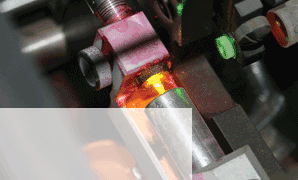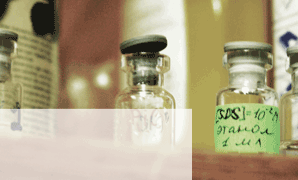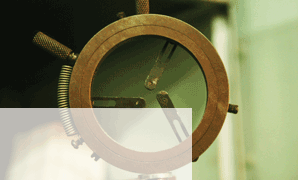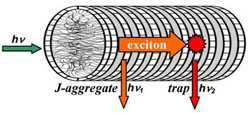 |
Home  Team Team  Contact us Contact us |
| About us | Our activity | Highlights | Publications | Gallery | New events |
| RE-doped nanocrystals | J-aggregates | Cell marking | Inorganic synthesis | Organic synthesis |
 |
 |
 |
Exciton transport in J-aggregates
One of unique properties of J-aggregates is exciton migration over hundreds of monomers. Due to this feature, J-aggregates can be considered as optical antenna for energy delivery purposes. Exciton properties of J-aggregates are similar to those of light-harvesting complexes (LHC), which provide extremely fast and efficient energy transport of the absorbed sun light to the photochemical reaction center of plants and photosynthetic bacteria. Indeed, it was shown that the J-aggregates of cylindrical structure are the most promising artificial systems to mimic LHCs.
There is a significant contradiction in the efficiency of exciton energy migration reported by different authors. According to some reports, an exciton migrates in J-aggregates over up to several hundred molecules, while sometimes an exciton motion over 104 molecules at room temperatures is stated. One of the main questions to be answered in this connection is the mechanism of the exciton transport in J-aggregates (coherent or incoherent). Mainly, the exciton transport in J-aggregates is considered to be coherent, i.e. the exciton propagates along the molecular chain as a wave packet. However, incoherent hopping of excitons over adjacent delocalization segments is supposed as well.We are studying exciton migration in J-aggregates using exciton traps dyes with absorption and luminescence at longer wavelength corresponding to J-aggregate.

Our results:
1) Using a luminescent exciton trap, a mechanism of the exciton migration in disordered J-aggregates of amphiphilic analogue of pseudoisocyanine (amphi-PIC) dye has been investigated in the temperature range of 80 300 K. Due to a strong topological disorder in amphi-PIC J-aggregates observed in a binary dimethylformamide-water (DMF/W) solution with a low water content, two types of excitonic states have been revealed: delocalized exciton state that forms the main part of the J-aggregates absorption band (J-band), and a state of strongly localized excitons that forms the long-wavelength edge of the J-band. These excitonic states are characterized by the different mechanism of the exciton transport: a coherent mechanism for delocalized excitons and an incoherent one for localized excitons (read more). As localized excitons provide a small contribution to the J-band and appear only at high degree of topological disorder, the coherent mechanism of the exciton transport in amphi-PIC J-aggregates has been concluded. Such a result is non-trivial due to a small delocalization length of excitons in amphi-PIC J-aggregates (11 monomers at 80 K) provided by the moderate energetic disorder and strong exciton-phonon coupling.
(a) Localized exciton band (dashed line) within the J-band (solid line), arrows point to different excitation sites. (b) Curves of temperature dependence of exciton trap luminescence intensity (registration at 680 nm) at the different excitation wavelengths: 583 nm (solid line); 587 nm (dashed line); 592 nm (dash-dotted line); 610 nm (dotted line). Data are normalized to the value at T = 80 K for a clear presentation.
2) Using luminescent exciton traps, an efficiency of the exciton migration in J-aggregates of the amphi-PIC (read more) dye in solutions has been investigated. Applying a modified Stern-Volmer equation for analysis of the J-aggregates luminescence quenching by the trap, the quenching of 50% of amphi-PIC J-aggregates luminescence accessible for trapping at the ratio amphi-PIC/DiD = 120:1 has been revealed. To increase the exciton migration efficiency, the J-aggregate structure was improved by the formation of a "J-aggregate-surfactant complex. The J-aggregate structure improvement is confirmed by the about 3 times increase in the exciton delocalization length that leads to the 1.3 times enhancement in the exciton migration efficiency in solutions with the surfactant. The best of our knowledge, such a control of the exciton transport parameters in J-aggregates in solutions has not been demonstrated yet.

(a) Luminescence spectra of the J-aggregates with the DiD trap at different amphi-PIC/DiD ratios; (b) modified Stern-Volmer plot for amphi-PIC J-aggregate luminescence quenching by the trap.Main publications:
A.V. Sorokin, I.I. Filimonova, R.S. Grynyov, G.Ya. Guralchuk, S.L. Yefimova, Yu.V. Malyukin Control of Exciton Migration Efficiency in Disordered J-Aggregates// J. Phys. Chem. C. 2010. v. 114, Ή 2. P. 1299-1305. abstract A.N. Lebedenko, R.S. Grynyov, G.Ya. Guralchuk, A.V. Sorokin, S.L. Yefimova, Y.V. Malyukin. Coherent Mechanism of Exciton Transport in Disordered J-Aggregates// J. Phys. Chem. C. 2009 v. 113, Ή 29. P. 1288312887. abstract
R.S. Grynyov, A.V. Sorokin,G.Ya. Guralchuk, S.L. Yefimova, I.A. Borovoy, Yu.V. Malyukin. Squaraine dye as an exciton trap for cyanine J-aggregates in a solution // J. Phys. Chem. C. 2008. v.112, Ή 51. P. 2045820462. abstract
to the top
